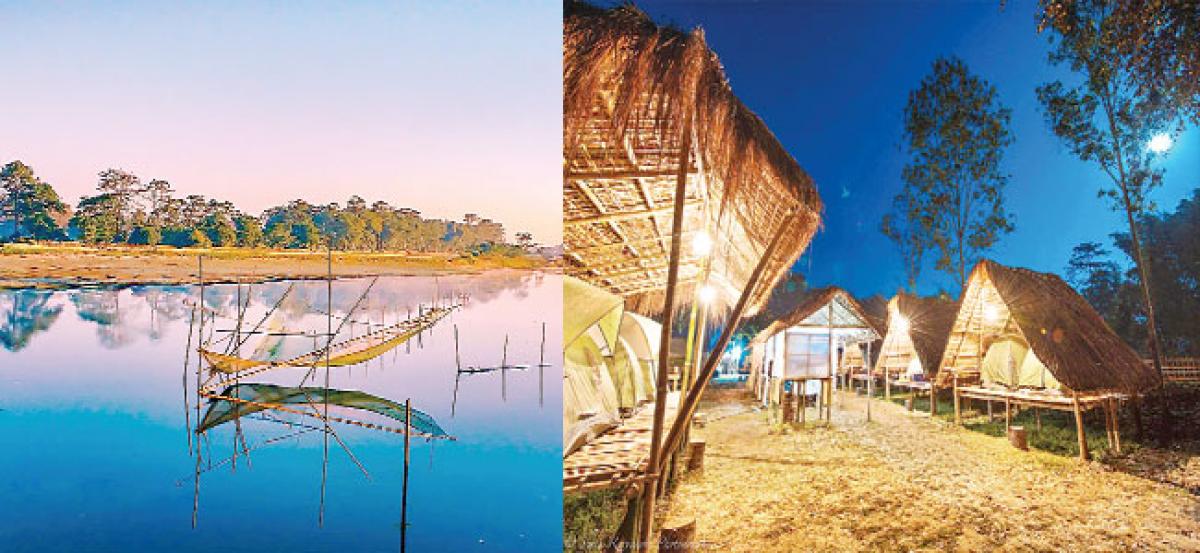Live
- Peace and development in Tripura, says HM Shah after meeting Reang tribals
- Two terror associates arrested with arms, ammunition in J&K’s Sopore
- L-G Saxena visits Delhi areas, says people's plight pathetic
- As temperatures drop to minus 8 in Kashmir, CM Omar Abdullah rushes back
- Case Filed Against Actor Mohan Babu: DGP Confirms
- Devarakadra MLA Madusudhan Reddy Urges Real-Life Heroism, Criticizes Allu Arjun’s Press Meet Remarks
- Where knowledge, values and talents flourished
- Selling Stories: Shaping Businesses and Lives
- Nimrat Kaur celebrates World Saree Day with a powerful message
- AP minister orders probe into fatal accident on Addanki-Narkatpally highway
Just In

Assam\'s Majuli faces flood fury -- and the threat of erosion -- whenever the mighty Brahmaputra river swells. So take a break from your high-tech lifestyle and hop on that double decker boat to live the simple life in the world\'s largest river island before it loses the title.
Assam's Majuli faces flood fury -- and the threat of erosion -- whenever the mighty Brahmaputra river swells. So take a break from your high-tech lifestyle and hop on that double decker boat to live the simple life in the world's largest river island before it loses the title.
Cruises on luxury vessels can take you to your destination, but to understand the locals' lives, it is best to travel like them on a rickety motor boat, which can also carry cars, bikes and anything that can't swim, from Neemati ghat to Kamalabari ghat.
First timers might fear for their lives but for the frequent travellers, it's like any other public transport. Some are so carefree that they even play cards.
After the half-hour ferry ride, you will reach the shrinking island, which is located over 300 km from Guwahati, Assam's main city, and is home to approximately two lakh people consisting of Brahmins, Kalitas, Mishings, Deori and more.
Visitors can stay in various resorts, which might remind you of your hostel days due to availability of only basic amenities, or limited homestays.While driving to your accommodation, you will see paddy and mustard fields, and bamboo plantations along the roads.
Out of the various house forms, the bamboo stilt houses -- with an open fireplace in the middle -- of the Mishing tribe, are quite unique, and you will see women working on looms made with bamboos and a cycle's wheel.
Unlike the people of Sualkuchi, a silk-weaving village in Assam, Mishings here make "mekhela chador" and other traditional outfits only for their own use. And men use their physical strength to make beds out of bamboos or other furnitures, when they are not farming.
Majuli, a hub of the Assamese neo-Vaishnavite culture, has many satras (religious and cultural institutions).
"Earlier, there were over 60 satras in Majuli but due to erosion, there are currently just 32 satras here. Auniati Satra is the biggest one in Assam. The land measures up to 500 bigha," Anant Kalita, the satra's museum guide, told this visiting IANS correspondent.
"We don't call ourselves monks or pandits. The ones who stay in satras are called Vaishnavs. We worship lord Krishna. We dance, pray and do dramas, which were created by (saint-scholar) Sankardev," he added.
The satra is open to all -- Brahmins, Kalitas and people from other communities of Assam.
"Even Muslims can come. Ladies can come but can't stay in the satra. After marriage, people need to stay out of the satra.
"There are 350 people in the satra. Vaishnavs and bhakhts stay in satras, the ones who are outside are called disciples," said Kalita, who has been here for the past 18 years.
The Samaguri Satra, on the other hand, has kept alive the tradition of mask-making.
Its studio houses numerous masks, like those of Narasimha, Ram and Laxman that are used during festivals and Bhaona, which is a traditional form of entertainment through which religious messages are shared.
Explaining the process of mask-making, popular mask artiste Hem Chandra Goswami's brother Tilak Goswami said: "The masks are made of mud, cotton cloth, cow dung and vegetable colours. One mask takes about 15 to 20 days to make."
"Our entire family knows how to make masks. We have been making masks for the last six generations," added the 65-year-old.
After learning the craft here, some even go to Dibrugarh or Guwahati.It's not just the people at satras who are warm and welcoming. Once the local children spot new faces, especially with DSLR cameras, they will happily follow you and strike a pose.
You might have to use a lot of hand gestures while communicating with the locals as they aren't fluent in English or Hindi, but they will leave you overwhelmed -- irrespective of their financial condition, they will not let you leave empty handed.
A cup of tea or a plate full of home-made sweets (rice flour pitha) is the least they can offer, and a request: "Please visit again."
By Natalia Ningthoujam

© 2024 Hyderabad Media House Limited/The Hans India. All rights reserved. Powered by hocalwire.com







